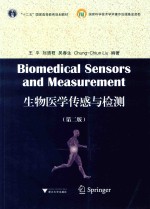图书介绍
生物医学传感与检测 第2版PDF|Epub|txt|kindle电子书版本网盘下载

- 王平,刘清君,吴春生编著 著
- 出版社: 杭州:浙江大学出版社
- ISBN:9787308151269
- 出版时间:2016
- 标注页数:293页
- 文件大小:39MB
- 文件页数:305页
- 主题词:生物传感器-检测-高等学校-教材-英文
PDF下载
下载说明
生物医学传感与检测 第2版PDF格式电子书版下载
下载的文件为RAR压缩包。需要使用解压软件进行解压得到PDF格式图书。建议使用BT下载工具Free Download Manager进行下载,简称FDM(免费,没有广告,支持多平台)。本站资源全部打包为BT种子。所以需要使用专业的BT下载软件进行下载。如BitComet qBittorrent uTorrent等BT下载工具。迅雷目前由于本站不是热门资源。不推荐使用!后期资源热门了。安装了迅雷也可以迅雷进行下载!
(文件页数 要大于 标注页数,上中下等多册电子书除外)
注意:本站所有压缩包均有解压码: 点击下载压缩包解压工具
图书目录
Chapter 1 Introduction1
1.1 Definition and Classification of Biomedical Sensors1
1.1.1 Basic Concept of Sensors1
1.1.2 Classification ofBiomedical Sensors2
1.2 Biomedical Measurement Technology2
1.2.1 Bioelectrical Signal Detection3
1.2.2 Biomagnetic Signal Detection3
1.2.3 Other Physiological and Biochemical Parameter Detection4
1.3 Characteristics of Biomedical Sensors and Measurement4
1.3.1 Features ofBiomedical Sensors and Measurement5
1.3.2 Special Requirements ofBiomedical Sensors and Measurement5
1.4 Development of Biomedical Sensors and Measurement6
1.4.1 Invasive and Non-Invasive Detection7
1.4.2 Multi-Parameter Detection7
1.4.3 In vitro andIn vivo Detection8
1.4.4 Intelligent Artificial Viscera9
1.4.5 Micro-Nano Systems10
1.4.6 Biochips and Microfluidics11
1.4.7 Biomimetic Sensors11
References12
Chapter 2 Basics of Sensors and Measurement13
2.1 Introduction13
2.2 Sensor Characteristics and Terminology14
2.2.1 Static Characteristics14
2.2.2 Dynamic Characteristics16
2.3 Sensor Measurement Technology19
2.3.1 Measurement Methods19
2.3.2 Sensor Measurement System21
2.3.3 Signal Modulation and Demodulation23
2.3.4 Improvement of Sensor Measurement System30
2.4 Biocompatibility Design of Sensors31
2.4.1 Concept and Principle of Biocompatibility31
2.4.2 Biocompatibility for Implantable Biomedical Sensors34
2.4.3 Biocompatibility for In vitro Biomedical Sensors36
2.5 Microfabrication of Biomedical Sensors39
2.5.1 Lithography39
2.5.2 Film Formation39
2.5.3 Etching40
2.5.4 Design of the Biomedical Sensors42
References44
Chapter 3 Physical Sensors and Measurement47
3.1 Introduction47
3.2 Resistance Sensors and Measurement48
3.2.1 Resistance Strain Sensors48
3.2.2 Piezoresistive Sensors59
3.3 Inductive Sensors and Measurement62
3.3.1 Basics62
3.3.2 Applications in Biomedicine80
3.4 Capacitive Sensors and Measurement81
3.4.1 The Basic Theory and Configuration of Capacitive Sensors81
3.4.2 Measurement Circuits87
3.4.3 Biomedical Applications90
3.5 Piezoelectric Sensors and Measurement96
3.5.1 Piezoelectric Effect96
3.5.2 Piezoelectric Materials98
3.5.3 Measurement Circuits99
3.5.4 Biomedical Applications102
3.6 Magnetoelectric Sensors and Measurement106
3.6.1 Magnetoelectric Induction Sensors106
3.6.2 Hall Magnetic Sensors110
3.7 Photoelectric Sensors115
3.7.1 Photoelectric Element115
3.7.2 Fiber Optic Sensors123
3.7.3 Applications of Photoelectric Sensors124
3.8 Thermoelectric Sensors and Measurement126
3.8.1 Thermosensitive Elements126
3.8.2 Thermocouple Sensors128
3.8.3 Integrated Temperature Sensors130
3.8.4 Biomedical Applications132
References134
Chapter 4 Chemical Sensors and Measurement137
4.1 Introduction137
4.1.1 History137
4.1.2 Definition and Principle139
4.1.3 Classification and Characteristics139
4.2 Electrochemical Fundamental140
4.2.1 Measurement System140
4.2.2 Basic Conception142
4.2.3 Classification of Electrodes147
4.3 Ion Sensors149
4.3.1 Ion-Selective Electrodes149
4.3.2 Ion-Selective Field-Effect Transistors155
4.3.3 LightAddressable Potentiometric Sensors159
4.3.4 Microelectrode Array163
4.4 Gas Sensors167
4.4.1 Electrochemical Gas Sensors167
4.4.2 Semiconductor Gas Sensors170
4.4.3 Solid Electrolyte Gas Sensors177
4.4.4 Surface Acoustic Wave Sensors180
4.5 Humidity Sensors183
4.5.1 Capacitive Humidity Sensors184
4.5.2 Resistive Humidity Sensors185
4.5.3 Thermal Conductivity Humidity Sensors186
4.5.4 Application187
4.6 Intelligent Chemical Sensor Arrays189
4.6.1 e-Nose189
4.6.2 e-Tongue196
4.7 Micro Total Analysis System201
4.7.1 Design and Fabrication201
4.7.2 Applications209
4.8 Sensor Networks209
4.8.1 History of Sensor Networks210
4.8.2 Essential Factors of Sensor Networks210
4.8.3 Buses of Sensor Networks211
4.8.4 Wireless Sensor Network214
References219
Chapter 5 Biosensors and Measurement223
5.1 Introduction223
5.1.1 History and Concept of Biosensors223
5.1.2 Components of Biosensor224
5.1.3 Properties of Biosensors226
5.1.4 Common Bioreceptor Components226
5.2 Catalytic Biosensors227
5.2.1 Enzyme Biosensors227
5.2.2 Microorganism Biosensors231
5.3 Affinity Biosensors233
5.3.1 Antibody and Antigen Biosensors233
5.3.2 Nucleic Acid Biosensors240
5.3.3 Receptor and Ion Channel Biosensors244
5.4 Cell and Tissue Biosensors247
5.4.1 Cellular Metabolism Biosensors248
5.4.2 Cellular Impedance Biosensors251
5.4.3 Extracellular Potential Biosensors254
5.5 Biochips258
5.5.1 Chips of Microarray259
5.5.2 Gene and Protein Chips259
5.5.3 Tissue and Cell Chips264
5.5.4 Lab-on-a-Chip266
5.6 Nano-Biosensors268
5.6.1 Nanomaterials for Biosensors269
5.6.2 Nanoparticles and Nanopores Biosensors270
5.6.3 Nanotubes and Nanowires Biosensors278
References284
Index289